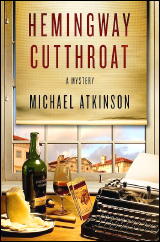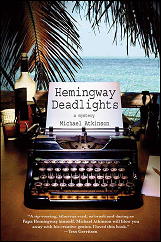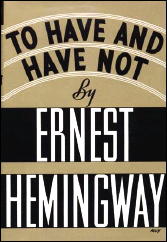Tue 3 Aug 2010
A Review by David L. Vineyard: MICHAEL ATKINSON – Hemingway Cutthroat.
Posted by Steve under Reviews[2] Comments
MICHAEL ATKINSON – Hemingway Cutthroat. St. Martin’s, hardcover, July 2010.

Ernest Hemingway, fresh to Spanish shores to write about and participate in the Spanish Civil War is …
A good start for Michael Atkinson’s second darkly humorous mystery (following Hemingway Deadlights, 2009) to feature a somewhat bemused Papa Hemingway as reluctant sleuth.
Though Hemingway (and especially that famous lost suitcase and missing novel of his) has featured in mystery and suspense novels before (notably by Bill Granger and Dan Simmons), Atkinson has taken a unique turn eschewing any attempt to recreate the Hemingway style or voice while managing to suggest it whenever he puts us in Hemingway’s mind, and taking a decidedly cock-eyed look at the author’s famous machismo without parodying or laughing at it.
After being skinned in a game of Mus and participating in a bullfight in a Madrid basement Hemingway finds himself trying to uncover who murdered Pazos, a bureaucrat in the Popular Front and an old pal of Papa’s from the First World War, and accompanied by his friend and literary rival John Dos Passos. [FOOTNOTE]
Murder novels set in wartime settings can be tricky things, and amid the Spanish Civil War — a rehearsal for the Second World War with the Nazis on the Royalist side and Stalin and much of the West on the Republican side — the fate of one man amid so much slaughter is a tough sell, but Atkinson manages to bring it off both thanks to his cranky sense of humor and a convincing, if offbeat, portrait of Hemingway as a boozing, brawling, but loyal friend who won’t let go short of uncovering the killers and the motive behind the death of Pazos.

And there are plenty of suspects on both sides. Spain in the Civil War was a treacherous place. Aside from the war the Republican side was haunted by Soviet purges designed to cover up their general incompetence against the Nazi blitzkrieg, and the hot blooded and violent nature of the people themselves.
Atkinson uses this as the basis of a good deal of grim humor and populates the novel with a collection of colorful types who complicate Hemingway’s investigation, including Dr. Florapedes Crespo, his friend Pazos mistress:
Hemingway may seem an unlikely sleuth, but he was a fan of both Dashiell Hammett (he wrote To Have and To Have Not largely as his ‘answer’ to what he perceived as the false idea that the tough guy was uniquely suited to survival that he thought was Hammett’s theme), and Raymond Chandler, and a champion of Georges Simenon and Maigret from his years in Paris where Gertrude Stein introduced him to the joys of the Maigret novels.
He may not be a particularly cerebral sleuth, but as a two-fisted investigator with trench coat and booze in hand he is well suited to the rough and tumble investigation style of Atkinson’s humorous and suspenseful novels, and his years as a crime reporter in Kansas City add a certain reality to the conceit of Hemingway as detective.

Hemingway soon puts the pieces together and finds himself both hunter and hunted as he puts together the story of Pazos death at risk to life limb and the few illusions he has left until an effecting, ironic, and surprisingly powerful conclusion:
But he wasn’t, and he wasn’t satisfied or anything like it either. He was merely caught by the sentence he’d been writing, which was about killings and bad memories, and he could hear the heart pulse of it better in his head now, better than before. Hemingway went back to it, pencil to paper, quickly because he didn’t want it to escape. When it rolled further, by its own steam, he smiled. Where he was in that sentence, it was vicious and dark, but it was better than where he was. It was safe, it had balance, and it was his.
It is one of the few times Atkinson apes the Hemingway voice to any extent, and he gets it right and at the right time, and in the right place, and for the right reason.
I’ll look for Atkinson’s first novel and keep an eye out for later books that may emerge, whether they feature Papa Hemingway as sleuth or not. Atkinson has a good ear for dark humor and even a touch of slapstick, and in this relatively short and suspenseful book has produced a good evocation not only of Hemingway, but of the dark and terrible price of a modern yet ancient land in wartime.
[FOOTNOTE] The novel makes a good deal of the debate between Hemingway and Dos Passos on the subject of experience versus imagination in a work of fiction, and while it is true Hemingway set out to experience the things he would write about, he also wrote in the Nick Adams story, “On Writing” (also quoted above):
August 3rd, 2010 at 10:49 pm
Thanks for the tip on this. Sounds like something I’d enjoy. I’ve ordered both books in the series.
August 4th, 2010 at 12:51 am
Hemingway is the one writer I dare not read when I write fiction. That rhythm is so easy to fall into — and so hard to do right — that you can find yourself writing faux Hemingway (and bad Hemingway — there is even a Bad Hemingway Contest) all too easily.
Even if you don’t like the man or his books you have to see why his style was so seductive to an entire generation. It is far and away one of the most distinctive voices in fiction. Sadly it is also prone to self reverence and imitation, becoming a parody of itself — even in Hemingway’s hands.
But however you feel about him you can’t get away from him. Trying to ignore him and his impact on modern fiction is like trying to take Shakespeare out of the equation or Conan Doyle out of the detective story.